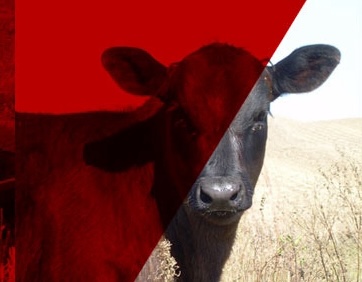Although drought conditions are a normal part of the weather cycle, cattle producers face serious challenges when regular feed supplies run low. When familiar feed resources begin to disappear, how can producers formulate a balanced ration with new or purchased alternatives?
First, Understand How Cattle Digest Feed
Cattle are ruminants, meaning their digestive system is more complex than humans, pigs, or chickens, which only have one stomach. Instead of a single compartment, cattle have four stomach compartments, each playing a role in breaking down food. One of these compartments, the rumen, acts as a large fermentation vat, holding trillions of microbes that help digest tough forages like hay and grass. As humans, with a monogastric stomach, we wouldn’t be able to survive on roughages, but ruminants rely on these microbes to break down and digest tough forages into energy.
Feeding Cattle Is More Than Just Giving Them Feed
Feeding cattle is not as simple as it seems. Both the rumen microbes and the animal itself need to have a balanced ration to thrive.
When cattle eat protein-rich feeds, certain protein types are utilized by the microbes first. If the microbes use up all the protein, the animal may not get enough later when it digests food in the intestine, resulting in a protein deficiency for the animal. That’s why understanding the difference between ‘microbial protein’—produced by rumen microbes—and ‘by-pass protein’—which passes through the rumen and is utilized by the animal directly—is crucial when balancing rations.
There are other tricky considerations to make when balancing a ration. Risks can include:
- Bloat
- Acidosis (rumen pH imbalance, typical on a high grain, low fiber diet)
- Feeding a rich diet too quickly
- Mineral and vitamin deficiencies or toxicities
- Nitrate toxicity.
Because ruminants’ diets are complex, gathering information about your cattle, operation, and feedstuff is key to balancing a ration effectively. Doing the prep work beforehand not only helps ensure a well-balanced diet tailored to your herd, but also allows those assisting to serve you efficiently.

Questions to Answer Before You Talk to a Ruminant Nutritionist
Dr. Karla Wilke, Nebraska Extension Beef Specialist, has helped producers balance rations through multiple droughts. Wilke emphasizes the importance of answering these questions before formulating a ration.
Information about Your Operation
- What feed do you have on hand? And how many tons?
- Do you have grazing pasture, hay, or a drylot?
- Can you get protein and energy sources (like corn or distillers grains)?
- Do you have a recent nutrient analysis on your feeds? Have you tested your feed/hay?
- For example, a hay sample was taken, and you have the lab results.
- Do you have a way to grind hay?
- Or will you be feeding the hay as long stem hay?
- What kind of equipment do you have access to?
- Do you have a mixer of some kind or a feed truck?
- Do you have a way to weigh the feed?
- Or will you have to estimate the weight of the feed fed?
- If you are buying a commercial feed, request a copy of the feed tag.
- Are their certain commodities you can buy?
- Distillers grains, soy hull pellets, etc.
- How much storage do you have? Is it possible to handle bulk commodities (like a semi-load of wet distillers grains)?
Information About Your Cattle
- What size are your cows or calves?
- Weight
- Body Condition Score (BCS)
- How many animals are being fed?
- What are your goals?
- Keep body condition?
- Help the cows to breed back?
- Target gains per day for growing animals?
- Are the cows pregnant (gestating) or milking (lactating)?
- When did the cows calve?
- When will the cows go to grass?
- What type of forage will the cows graze?
- Annual forages, cornstalks, native Sandhills, cool season pastures are examples.
- What type of forage will the cows graze?
- How often will you provide supplements (protein and/or energy)?
- How easy is it for you to supplement?
- Are the cattle close to headquarters?
- Do you have equipment to supplement?
- Are the cows close to home or far away?
- How easy is it for you to supplement?
Work With Extension Specialists/Educators
Finding a qualified ruminant nutritionist is a priority. One place to start is with Educators and Specialists at Nebraska Extension. Below is a contact list of Nebraska Extension Staff who can help you balance a ration for your herd.
Answer the questions listed above and contact one of these Extension staff to balance a ration for your feeds, resources, and cattle.
- Aaron Berger Extension Educator located in Kimball, aberger2@unl.edu, 308-235-3122.
- Connor Biehler, Extension Educator located in Ithaca, cbiehler2@unl.edu, 402-624-8007
- Mary Drewnoski, State Extension Beef Specialist located in Lincoln, mary.drewnoski@unl.edu, 402-472-6289.
- Erin Laborie, Extension Educator located in Beaver City, erin.laborie@unl.edu, 308-268-3105.
- Kacie McCarthy, State Extension Beef Specialist located in Lincoln, kacie.mccarthy@unl.edu, 402-472-6074.
- TL Meyer, Extension Educator located in Thedford, tl.meyer@unl.edu, (308) 645-2267.
- Brent Plugge, Extension Educator located in Kearney, brent.plugge@unl.edu, 308-236-1235.
- Rick Rasby, State Extension Beef Specialist located in Lincoln, rrasby1@unl.edu, 402-472-6477.
- Randy Saner, Extension Educator located in North Platte, randy.saner@unl.edu, 308-696-6784.
- Troy Walz, Extension Educator located in Broken Bow, troy.walz@unl.edu, 308-872-6831.
- Karla Wilke, State Extension Beef Specialist located in Scottsbluff, kjenkins2@unl.edu, 308-632-1245.
The bottom line is that drought makes feeding cattle more difficult, but there are solutions. By gathering the right information and seeking guidance from an expert, you can keep your cattle’s diets safe and balanced.
Since drought is inevitable, being proactive, knowing your options, and planning ahead before feed shortages hit can make all the difference.
Authored by: Josie Crouch & Bethany Johnston, Nebraska Extension Educators.

